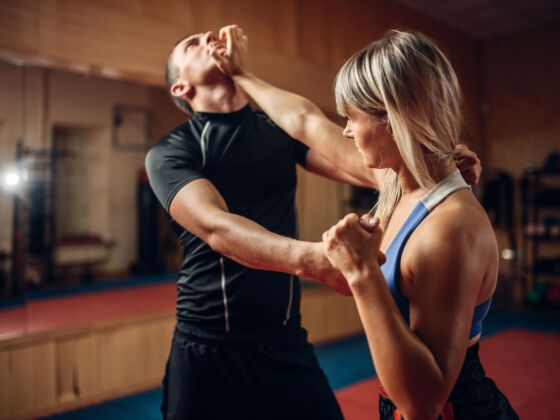The first time that I assisted in teaching a women’s self-defense class, I ended up facedown in the dirt. To prove women don’t have to be helpless in a physical situation, Sensei Cooper directed me to grab April — one of the smallest women I’ve ever trained with — in a triangle choke from behind. A half-second before I locked the hold in place, April threw an elbow into my stomach and a kick against my knee before reversing my weight to send me flying. When I looked back up, April was smiling.

Empathy, Empowerment, and the Biggest Lessons From a Women's Self Defense Class
The rest of the women in the class weren’t. Most of them looked frightened and perturbed. Where sensei and the rest of the team saw a well-executed escape and reversal, most of the women training with us were disturbed by something they had never seen before up close. If that kind of physical prowess was what it took to ward off an attacker, how many untrained people — not just women — could really pull it off?
April had been training years longer than I had. Though I was stronger and faster, she understood technique and execution better than I did, and she trusted that knowledge to carry her through the fight. The sense of relief everyone felt while Sensei Cooper explained all of this was palpable.
But the fear was still there.
I took the opportunity to study the crowd after climbing to my feet. Most of these women were approaching middle age, and some were past it. Many were overweight or overdressed and seemed unprepared to be thrown around on the ground. In a crowd of less than twenty, I was looking at women of all ages and backgrounds, all with one shared gap in knowledge.
The techniques we taught that day covered foundational basics: simple wrist and arm breakaway techniques, using weight and light footwork to throw an attacker from behind, and last resort strike points to unnerve aggressors and provide a window to escape. The goal behind each technique wasn’t to fight but to disengage and escape, and most of the women left with a confidence boost and an offer to go further than an introductory course.
As Sensei wrapped up with the last few students and the rest of us began packing up the gear, I couldn’t get that look of fear I’d seen earlier out of my head. To a student, every person in the room had known immediately that they were out of their depth. April, on the other hand, was not. Training was part of her daily life, and because she was so small, she was accustomed to acting at a disadvantage. Forged by years of training and focus, the gulf between those two extremes was staggering.
Someone told me once that no matter how you try to keep your options open, those options eventually begin to narrow. By choosing to do one thing, you’re also choosing to not do literally every other thing that could occupy the moment. There’s a lesson in balance and moderation somewhere in there, but studying the worried look across that crowd struck a certain chord with me.
By nature, I’m not an empathetic person. Generally, I believe that emotion clouds judgment and that the best decisions are made with a proper frame of reference inside a stable headspace. The flaw in that mindset is that humans aren’t logical creatures, and even the best choice is weighted by some emotional factor — whether we like it or not.
True objectivity may be beyond the scope of human achievement.
Empathy isn’t. Seeking to understand others on an emotional level is challenging in its complexity, but it’s not foreign to the human condition. Since studying that class, I’ve always tried to go out of my way to better understand the emotions surrounding the junction between courage and fear.
It’s still something I see regularly. First-time martial artist students visiting a dojo for a free class or their first lesson don’t always see training on the dojo floor. They see an incomprehensible mechanism of technique and motion — of orderly chaos — all incomprehensible at first glance. Most enterprising (and entrepreneurial) small business owners use this uneasiness to run special “introductory” courses that help ease newcomers into the inner workings of the dojo. That’s a business practice based on empathy, on understanding and navigating a sense of overwhelming unease.
I know because I’ve participated in both roles. In my first dojo, I was the primary contact for many students during their first lessons. As one of the highest-ranked individuals in my first dojo, I worked with newcomers on basic footwork and politely sparred with them. When I left town and joined a new dojo, someone worked with me to overcome my apprehension and show me the ropes.
The empathy that I’ve learned through training and educating others in martial arts is something I learned between the martial drills and endurance exercises, and probably one of the most critical skills I’ve gained during my time on the mat. I’ll be the first to admit that even now, I’m not a natural empath and, for me, relating on that level takes a conscious effort.
But I can do it, and I’m a better person for it when I try.